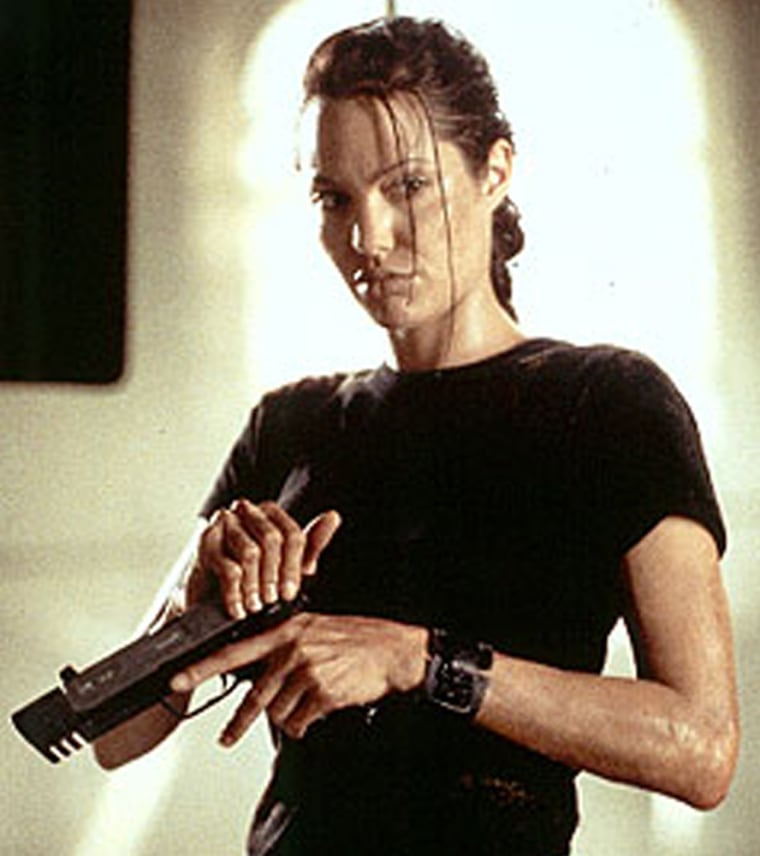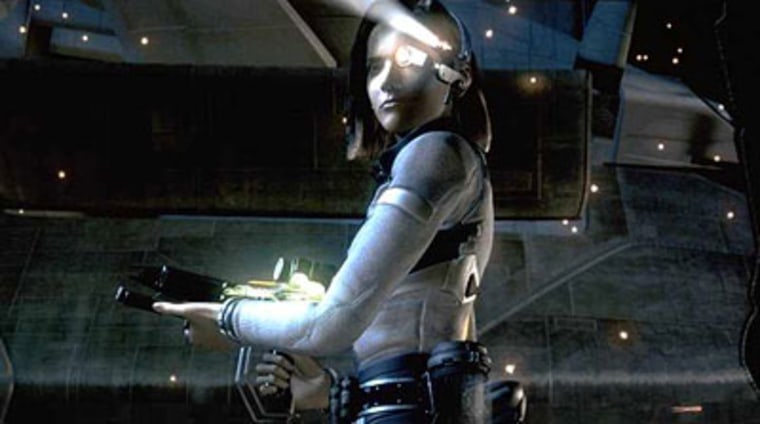In the beginning there was “Super Mario Bros.”In 1993, Hollywood blew millions on a film about a mustachioed plumber named Mario. That the Mario of the film title was based off a video game character was strange. Stranger still was the 140-minute run-time, longer than “Citizen Kane.”
“Super Mario Bros.” tanked among filmgoers, the bong-and-waffles set excluding. Yet neither Hollywood nor the paying public learned their lesson. Over the following decade we saw video game inspired films like “Mortal Kombat,” “Final Fantasy: The Spirit Within” and this Friday's release of “Doom.”
Trash, all of it. But with geek auteur Peter Jackson set to apply his chubby fingers to the adaptation of the Xbox game, “Halo,” and perhaps infect an average SciFi plot with (shudder) emotional resonance, we may look back at the last decade as the golden age of bad video game films.
Let's celebrate the trash that is the video game-based movie with a look back at the low/high points. Readers are warned. Spoilers lurk in the paragraphs below. But if you're the type to get upset over spoilers in these types of movies, well, perhaps you should be separated from your Blockbuster card.
“Mortal Kombat” (1995)
Years before there was a “Grand Theft Auto” to kick around, politicians, church groups and the media had "Mortal Kombat." The martial arts fighting game boasted a high punch-to-blood-spillage ratio. Each punch and kick yielded buckets of blood which in early 1990s PC graphics technology looked more silly than frightening.Infamy came with “Mortal Kombat’s” signature finishing moves. Players who had memorized certain key strokes combinations could execute a special finishing move like, say, ripping out the skull and spinal column of the vanquished and hoisting the gore on high like the Stanley Cup. Stories on how “Mortal Kombat” was corrupting America's youth led the local news. Pundits pontificated. Politicians bloviated. And across the country, kittens and puppies cried for no reason.
Naturally, Hollywood stepped in.
1995's “Mortal Kombat” did more to end the controversy surrounding the game than all the media hand-wringing ever could. Let's start with Christopher Lambert wearing a Chinese conical hat and talking like Wolfgang Puck. The techno soundtrack sounded like it was pilfered from a disco in Monaco. Or how about the fighting? Pillow fights on “Blossom” have been more intense.Fighters like “Scorpion,” “Johnny Cage” and “Sonya Blade,” evoked dread in the game. In the film they evoked the names of spin instructors. Yet the tale about a group of warriors enlisted to battle to the death to save the world struck a chord among filmgoers. It grossed $125 million worldwide. The actors went on to star in Cinemax late night erotic thrillers. And director Paul W. S. Anderson established himself as king fan boy. His other credits include “Alien vs. Predator” and “Resident Evil.”
Video game moment: Bad guy Shang Tsung uses the game's key phrase, “Finish Him!” several times throughout the film.Shadowy organization: An evil empire in a parallel realmFor the fan boys: Heroine Sonya Blade is captured by Shang Tsung and made to wear a mini-skirt.
“Lara Croft: Tomb Raider” (2001)
The original PC game “Tomb Raider” had gamers exploring hidden ruins, dodging dinosaurs and taking in what was then in 1996 considered state-of-the-art 3D graphics.

What ensured the game's place in pop culture history, however, was the explorer-protagonist, Lara Croft. Or rather Lara's Crofts, a pair of physics-defying orbs that had fan boys replacing their Red Sonya screensavers with shots of the pistol strapping, short-shorts wearing, explorer-minx overnight. By the time Hollywood got into the act with 2001's “Lara Croft: Tomb Raider,” the games series had lost its cachet among serious gamers. But if Hollywood couldn't be timely, it could at least go weird — which it did by casting Angelina Jolie as the lead.As film adaptations of video games go, “Lara Croft: Tomb Raider” is not unwatchable. Sets like the subterranean Angkor Wat and palatial Venetian ballrooms were a far cry from the Styrofoam rocks of “Mortal Kombat.”“Lara Croft” established the template for all video game based movies to follow. Shadowy organization intent of ruling the world? Check. Monsters? Check. Requisite near nude scene with young starlet? Check. And they managed to throw in a storyline involving Lara's love for her dead father (played by real-life father Jon Voight). Jolie not only looked the part — at least as much as a mere human could look like the digital fantasy of millions — but she sounded great; not so much reading her lines but purring them in an accent best described as Oxbridge meets Rich Daddy's Little girl.Video game moment: A room-sized spinning device in the final scene has Lara Croft hopping from one platform to the next.Shadowy organization: The IlluminatiFor the fan boys: Jolie takes a shower. No nudity, but she does spend a lot of time underneath the shower-head open-mouthed.
“Final Fantasy: The Spirits Within” (2001)
Also known as “Attack of the Doll-Eyed Plastic People,” this CGI-animated film forever equated the popular two decade-old “Final Fantasy” game series with hammy dialogue and a new agey philosophy usually found in the books sold near the Pottery Barn cash register.
To these accusations fans of the actual game must plead guilty. But in defense, “Final Fantasy” is a Japanese role-playing-game and that's how they roll.
Serious gamers either love “Final Fantasy” for its inspired parallel world-like settings and recurring storylines of fights against oppression or they hate it for the sappiness that drips from every non-interactive cut-scene.When it came to the actual movie everyone, gamer and non-gamer, hated it. “Final Fantasy: The Spirits Within” lost $120 million worldwide.
Set in the future where phantom aliens have sent Earthlings packing for bubble cities with all the soul of downtown Salt Lake City at night, a young scientist attempts to save the world by harnessing the “Gaia,” or life force, of the Earth. This sets in motion a struggle between the military who want to just torch the Earth and be done with it and the scientist's Deepak Chopra-spewing peers.

The real reason for “Final Fantasy: The Sprits Within” failure was not the plot, but the CGI-animation. It was revolutionary enough to capture character shading, clothing texture and even hair at a level never scene in a feature length film. But character faces and eyes failed to evoke emotion. The effect was unsettling ... like watching Jessica Simpson act in “Dukes of Hazzard.” Video game moment: A shoot-out in old New York between phantom aliens and the militaryShadowy organization: A general and his henchmen display a Strangelovian “Jack. D. Ripper” complex.For the fan boys: Alas, the female cartoons remain clothed at all times.
“Resident Evil” (2002)
Evil corporations! Viral experiments! Zombies!

Not content to stick with one theme and run with it, “Resident Evil” offered filmgoers a whole smorgasbord of subplots in the hopes that they just abandon all hope of subtlety and enjoy the sights of Milla Jovovich kicking a little undead bootie.Blame not the filmmakers. For nearly a decade the game series “Resident Evil” has been telling and re-telling the story of how one corporation's dabbling in biological weaponry turned the residents of nearby Raccoon City into zombies. The original “Resident Evil” in 1996 invented the genre called “survival horror,” a style that leans heavily on equal parts zombie films and Guns & Ammo magazine.
The film skips the spooky wooded areas around Raccoon City, scene of many of the game series' action, for the headquarters of the Umbrella Corporation, a slick glass and white-walled institution located hundreds of feet below the city.Someone has released an experimental virus. Now the corporation employees are working stiffs, literally. They want brains. But Jovovich and Michelle Rodriguez and various nameless dudes that all look the same have something else for the zombies. The film is nowhere near as gory as the game. Nor as frightening. Where “Resident Evil” the game uses clichéd (but effective) scenes in dilapidated houses and spooky forests for cheap thrills, the film opts for scenes of hundreds of zombies charging over office furniture. It's “Aliens” meets “Dilbert.”Favoring action over suspense and Michael Bay over John Carpenter, the film suffers when compared to the gaming series. But the sets sure do look expensive. And Jovovich is almost as much fun to watch as it is to say “Milla Jovovich.” Video game moment: Jovovich delivers a round-house kick to a zombie Doberman. Shadowy organization: The Umbrella Corporation. Imagine Microsoft, General Electric and a dash of al-Qaida.For the fan boys: Jovovich wears a paper-thin red slip and high motorcycle boots throughout the movie. Oh ... and a shower scene.
“Doom” (2005)
This seminal PC game wasn't the first-person-shooter, but it was certainly the “baddest”; combining science fiction, satanic imagery and creative use of rocket launchers and chainsaws.Throughout two of its three incarnations, “Doom” (1993), “Doom II” (1994) and “Doom III” (2005) the story has remained the same. The player is a space marine sent to Mars to close a portal of Hell. With the help of an ever-increasing array of weapons, conveniently placed ammo packs and ubiquitous exploding garbage cans, the marine makes his way past hell spawn in search of the big kahuna.With each successive version of “Doom,” the graphics engine grew more sophisticated. Shadows and dynamic lighting added depth to darkened corridors. And the monsters, once pixilated blobs, took on realistically rendered muscles and a sweaty sheen. By the time of “Doom III,” the graphics were so real that people admitted to playing the game with the lights on — and a pack of Depends by their side.Given all this, Doom's recipe for cinematic success seemed simple enough. Place the gates of Hell on Mars and populate it with creatures meaner than Naomi Campbell on a Red Bull and vodka bender. Add a couple macho space marines and give them guns. Lots of guns ... including the BFG, the “big f--king gun.” Oh yes, and throw in a chainsaw, because on a treeless planet like Mars, nothing else makes a more direct statementA roomful of chimps could write this stuff. Alas, those chimps must have been working on another project, say “Deuce Bigalow,” because “Doom” the movie blows.Skipping any reference for hell, the film plays out a genetic experiment gone wrong on Mars. Zombies, not demons, are on the loose and the marines, led by Dwayne “The Rock” Johnson are sent into battle. Civilians by the hundreds are killed, by the marines no less — call the PC game cynical, but the only things that died in the game were monsters. The film further mucks things up with a brother-sister subplot that goes no where. And in one of the dumbest scenes in a genre that's no stranger to dumb, two marines engage in fisticuffs for a 10-minute scene that goes on for an eternity. And to top it off, the zombies look like they stepped off the “Thriller” video shoot. Gamers almost expect their intelligence to be insulted when seeing a cinematic adaptation of a game. But for the game itself to be insulted? To paraphrase a common gamer curse ... someone needs to get fragged!Video game moment: Towards the end of the movie the camera takes on a first-person-perspective. It plays less like the game and more like an old carney ride.Shadowy organization: Union Aerospace CorporationFor the fan boys: One space marine has a hot sister.